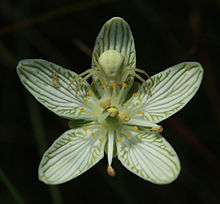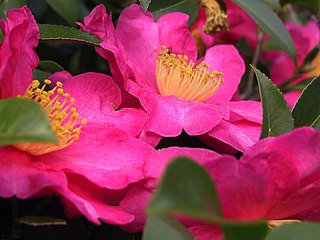
Camellia is a genus of flowering plants in the family Theaceae. They are found in eastern and southern Asia, from the Himalayas east to Japan and Indonesia. There are 100–300 described species, with some controversy over the exact number. There are also around 3,000 hybrids. The genus was named by Linnaeus after the Jesuit botanist Georg Joseph Kamel, who worked in the Philippines and described a species of camellia. Camellias are famous throughout East Asia; they are known as cháhuā in Chinese, tsubaki (椿) in Japanese, dongbaek-kkot (동백꽃) in Korean, and as hoa trà or hoa chè in Vietnamese.

The stamen is the pollen-producing reproductive organ of a flower. Collectively the stamens form the androecium.

A sepal is a part of the flower of angiosperms. Usually green, sepals typically function as protection for the flower in bud, and often as support for the petals when in bloom. The term sepalum was coined by Noël Martin Joseph de Necker in 1790, and derived from the Greek σκέπη, a covering.
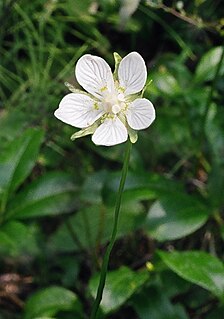
The genus Parnassia, also known as grass of Parnassus or bog-stars, are plants now placed in the family Celastraceae, formerly classified in Parnassiaceae or Saxifragaceae. The plants occur in arctic and alpine habitats, as well as in dune systems and fens, swamps, wet meadows, open seepage areas, moist woods, and across the Northern Hemisphere. It is actually not a grass, but an herbaceous dicot. The stalk of the plant can reach up to 8 inches (200 mm), the leaves up to 4 inches (100 mm) and the petals can be up to 1.4 inches (36 mm) wide. The flower has five white petals with light green venation. There are five three-pronged sterile stamens, each tipped with drop-like, false nectaries, which attract pollinating flies and bees.

Cornus canadensis is a species of flowering plant in the dogwood family, native to eastern Asia, the northern United States, Colorado, New Mexico, Canada and Greenland. Unlike its relatives, which are for the most part substantial trees and shrubs, C. canadensis is a creeping, rhizomatous perennial growing to about 20 cm (8 in) tall.
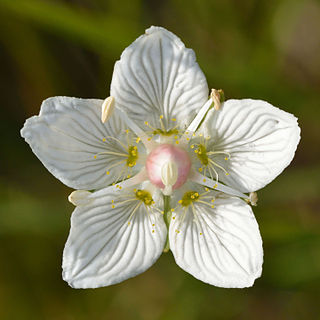
Parnassia palustris, commonly called marsh grass of Parnassus, northern grass-of-Parnassus, or just grass-of-Parnassus, and bog star, is a flowering plant in the staff-vine family Celastraceae.

Parnassiaceae Gray were a family of flowering plants in the eudicot order Celastrales. The family is not recognized in the APG III system of plant classification. When that system was published in 2009, Parnassiaceae were treated as subfamily Parnassioideae of an expanded family Celastraceae.
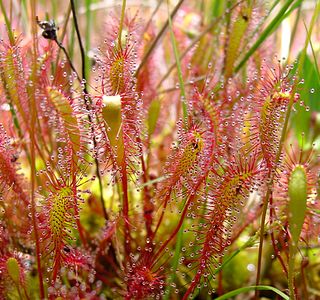
Drosera anglica, commonly known as the English sundew or great sundew, is a carnivorous plant species belonging to the sundew family Droseraceae. It is a temperate species with a generally circumboreal range, although it does occur as far south as Japan, southern Europe, and the island of Kauaʻi in Hawaiʻi, where it grows as a subtropical sundew. It is thought to originate from an amphidiploid hybrid of D. rotundifolia and D. linearis, meaning that a sterile hybrid between these two species doubled its chromosomes to produce fertile progeny which stabilized into the current D. anglica.
This page provides a glossary of plant morphology. Botanists and other biologists who study plant morphology use a number of different terms to classify and identify plant organs and parts that can be observed using no more than a handheld magnifying lens. This page provides help in understanding the numerous other pages describing plants by their various taxa. The accompanying page—Plant morphology—provides an overview of the science of the external form of plants. There is also an alphabetical list: Glossary of botanical terms. In contrast, this page deals with botanical terms in a systematic manner, with some illustrations, and organized by plant anatomy and function in plant physiology.

Grayson Glades Natural Area Preserve is a 31-acre (13 ha) Natural Area Preserve located in Grayson County, Virginia. Its centerpiece is an extremely rare wetland type known as a "mafic fen", which are situated upon soils rich in magnesium and fed by springs. The site is at the headwaters of a small stream system supporting additional mafic fens.

Dalibarda repens(dewdrop, false violet, star violet, Robin runaway. French Canadian: dalibarde rampante) is a perennial plant in the rose family, native to eastern and central Canada and to the northeastern and north-central United States. It is the only species in the genus Dalibarda, which is closely allied with the genus Rubus. The species is often included in the genus Rubus as Rubus repens (L.) Kuntze. It is fairly easily grown in shady locations in damp to wet, acidic soils, and is frequently used in wildflower and bog gardens as a ground-cover.

Parnassia californica is a species of flowering plant in the family Celastraceae known by the common name California grass of Parnassus. It is native to the mountains of Oregon, California, and Nevada, where it grows in moist areas such as meadows and streambanks.

Parnassia fimbriata is a species of flowering plant in the family Celastraceae known by the common name fringed grass of Parnassus. It is native to western North America from Alaska and northwestern Canada to the southern Rocky Mountains, where it is a plant of alpine and subalpine environments.

Papilionaceous flowers are flowers with the characteristic irregular and butterfly-like corolla found in many, though not all, plants of the species-rich Faboideae subfamily of legumes. Tournefort suggested that the term Flores papilionacei originated with Valerius Cordus, who applied it to the flowers of the bean.
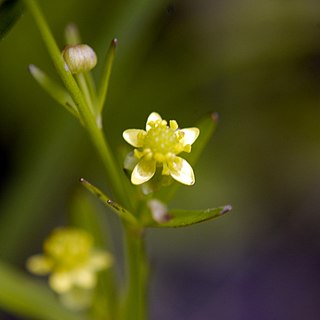
Ranunculus abortivus is a species of flowering plant in the buttercup family, Ranunculaceae. Its common names include littleleaf buttercup, small-flower crowfoot, small-flowered buttercup, and kidneyleaf buttercup. It is widespread across much of North America, found in all ten Canadian provinces as well as Yukon and the Northwest Territories, and most of the United States, except Hawaii, Oregon, California, and parts of the Southwest.

Trollius laxus is a rare flowering plant species in the buttercup family, Ranunculaceae. It is native to North America and is considered to have two subspecies, one with a distribution is the east and one in the west. Common names for Trollius laxus include American globeflower and American spreading globeflower. The American Globeflower, Trollius laxus is an endangered species of flowering plants Native to Northeastern United States. This species of plants is limited in range by their ability to exclusively survive in wetlands and marshes. Thus, clusters of the species are constantly threatened by the ever-changing hydrology of the range they are confined to.
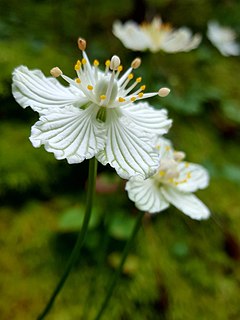
Parnassia caroliniana is a species of flowering plant in the Celastraceae known by the common name Carolina grass of Parnassus. It is native to the southeastern United States, where it occurs in North Carolina and South Carolina, with an isolated population in the Florida Panhandle.
A cataract bog is a rare ecological community formed where a permanent stream flows over a granite outcropping. The sheeting of water keeps the edges of the rock wet without eroding the soil; in this precarious location no tree or large shrub can maintain a roothold. The result is a narrow, permanently wet, sunny habitat.

Melaleuca glauca, commonly known as Albany bottlebrush is a plant in the myrtle family, Myrtaceae and is endemic to the south-west of Western Australia. It is a tall shrub with glaucous leaves and spikes of red flowers in spring.

Parnassia grandifolia, also known as bigleaf grass of Parnassus, is a flowering herbaceous plant of the family Celastraceae.
